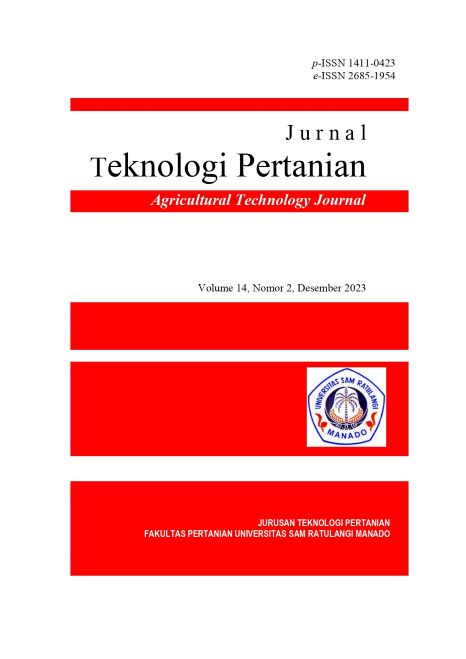Effect of Citric Acid Concentration on Physical and Chemical Properties of Potato (Solanum tuberosum L.) Flour
DOI:
https://doi.org/10.35791/jteta.v14i2.54532Keywords:
Superjhon potatoes, Citric acid, FlourAbstract
The aim of this study was to analyze the effect of citric acid concentration on the physicochemical properties of potato starch (Solanum tuberosum L.), especially the superjon variety. This study used a completely randomized design (CRD) method which consisted of 4 treatments and 3 repetitions. In treatment P0 (citric acid concentration 0% water 1000 ml). P1 (citric acid concentration 1% water 1000 ml). P2 (citric acid concentration 2% water 1000 ml) and P3 (citric acid concentration 3% water 1000 ml). The research results were processed using ANOVA, if there was a significant difference it would be followed by a 5% LSD test. The research results obtained were pH, 3.22-5.84, color, L* 69.53-75.76, a* -2.63-0.1, b* 13.03-19.63, levels water, 8.33-12.83%, ash content, 2.17-2.67%, gelatinization temperature 70.06-72.38°C, kamba density 0.81-0.85 gr/ml. The best physicochemical characteristics of potato starch were soaked in potato tubers in a 3% citric acid solution which had a characteristic L* value of 75.76, a* value of -2.63, b* value of 18.7, water content of 8.83%, degree acid (pH) 3.22, density 0.81 g/ml, gelatinization temperature 70.06°C, and ash content 2.17%. The use of citric acid in the processing of super jhon potato starch effectively inhibits the browning reaction. The characteristics of the flour produced have a significant effect, especially at higher levels of color brightness and low moisture content.
References
Ainah, N. 2004. Karakterisasi Sifat Fisik dan Kimia Tepung Biji Bunga Teratai Putih (Nymphae pubescens wild) dan Aplikasinya pada Pembuatan Roti. Skripsi, Institut Pertanian Bogor. Bogor.
Charley, H. 1982. Food Science. John Willey and Sons Inc., Canada.
Effendi, Z., Electrika, F., Surawan, dan Winarto. 2015. Effect of blanching and drying methods on physicochemical properties of orange sweet potato flour (Ipomoea batatas L.). Jurnal Agroindustri, 5(2), 109– 117.
Fajiarningsih, H. 2013. Pengaruh Penggunaan Komposit Tepung Kentang (Solanum tuberosum L.) Terhadap Kualitas Cookies. [skripsi]. Fakultas Teknik. Universitas Negeri Semarang. Semarang.
Fauzi,. M,. Daniyah, N., Rusdianto, S. A., dan Kuliahsari, E. d. 2017. Penggunaan vitamin C dan suhu pengeringan pada pembuatan chips (irisan kering) labu kuning LA3 (Cucurbita moschata). Jurnal Penelitian Pascapanen pertanian. 14(2), 108-115.
Hutchings, J. B. 1994. Food Colour and Appearance. Blackie Academic & Professional. Chapman & Hill. London.
Hustiany, R. 2006. Modifikasi Asilasi dan Suksinilasi Pati Tapioka sebagai Bahan Enkapsulasi Komponen Flavor. Disertasi Sekolah Pascasarjana Institut Pertanian Bogor, Bogor.
Inggrid. M., Daniel Setiadi L., Herry Santoso, dan Yansen Hartono. 2018. Pengaruh Penambahan Zat Anti-browning Alami pada Kentang. Prosiding Seminar Nasional Teknik Kimia’’ Kejuangan’’ Pengembangan Teknologi Kimia untuk Pengolahan Sumber Daya Alam Indonesia, Yogyakarta, 12 April 2018. Hal 1-7
Kuyu, C., Tola, Y., Mohammed, A.,dan Ramaswamy., H. 2018. Determination of Citric Acid Pretreatment Effect Of Nutrient Content, Bioactive Components, And Total Antioxidant Capacity Of Dried Sweet Potato Flour. Journal of Food Science And Nutrition. 6(6): 1-10.
Mardiah, Elida. 2011. Mekanisme Inhibisi Enzim Polifenol Oksidase Pada Sari Buah Markisa Dengan Sistein dan Asam Askorbat. Jurnal Riset Kimia. Vol. 4(2): 32-37.
Melidia. 2021. Pengaruh Konsentrasi Asam Sitrat terhadap Sifat Fisikokimia pada Tepung Umbi Suweg (Amorphophallus campanulatus). [Skripsi]. Fakultas Pertanian. Universitas Jambi. Jambi
Pangestuti E. K. 2021. Analisis Kadar Abu dalam Tepung Terigu dengan Metode Gravimetri. Jurnal Kimia dan Rekayasa. Universitas Setia Budi, 2(1):2747- 2841
Prabowo, B. 2010. Kajian Sifat Fisiko Kimia Tepung Millet Kuning dan Tepung Millet Merah. Skripsi. Universitas Sebelas Maret . Surakarta.
Queiroz, C., Lopes, M.L., Fialho, E., dan Valente-Mesquita, V.L. 2008. Polyphenol Oxidase: Characteristics and Mechanisms of Browning Kontrol. Food Reviews International. 24(4):361-375.
Radley, J.A. 1976. Starch Production Technology. Applied Science Publishers LTD. London.
Runtunuwu,. D.S,. Rogi, J. E. X., dan Palendeng, J. H. 2011. Identifikasi Varietas Kentang “Superjhon” Berdasarkan Penanda RAPD (Rapid Amplified Polymorphic DNA). Fakultas Pertanian. Universitas Sam Ratulangi.
Sasmitaloka, K.S., Widowati, S., and Sukasih, E., 2020, Karakterisasi Sifat Fisikokimia, Sensori, Dan Fungsional Nasi Instan Dari Beras Amilosa Rendah, J. Penelit. Pascapanen Pertan., 17 (1), 1–14.
Shodiq, M. H. 2016. Pengaruh Konsentrasi Asam Sitrat dan Suhu Pengeringan terhadap Sifat Fisik-Kimia Tepung Kulit Pisang (Musa paradisiaca). [Skripsi]. FTP Universitas Brawijaya. Malang.
Sudarmadji, S. Bmbang Haryono dan Suhardi. 1997. Prosedur Analisa Untuk Bahan Makanan dan Pertanian. Yogyakarta: Liberty
Syamsir, E., 2011. Learn Everything About Dietary Fiber. Kulinologi Indonesia. 14:2.
Valverde, J.C., and R. Moya. 2014. Correlation and modeling between color variation and quality of the surface between accelerated and natural tropical weathering in Acacia mangium, Cedrela odorata and Tectona grandis wood with two coating. Color Research and Application, 39(5): 519–529.
Wahyuningsih. 2010. Pengaruh Tirosin, Asam Askorbat, Enzim Polifenol, Xidase (PPO) Terhadap Perubahan Warna Kntang. Program Diploma III Teknik Kimia. Fakultas Teknik Universitas Dipenogoro, Semarang.
Wibowo, C., Erminawati, Pepita H., dan Rumpoko W.. 2017. Pengaruh Perlakuan Pendahuluan Terhadap Karakteristik Tepung yang Dihasilkan dari Umbi Kentang Varietas Granola. Purwokerto, 17-18 November 2017.
Winarno, F.G. 2008. Kimia Pangan dan Gizi. PT Gramedia. Pustaka Utama, Jakarta.
Wurzburg, O.B. 1989. Modified Starchs: Properties and uses. CRC Press Boca Raton Florida
Downloads
Published
Versions
- 2024-02-24 (2)
- 2024-02-24 (1)








